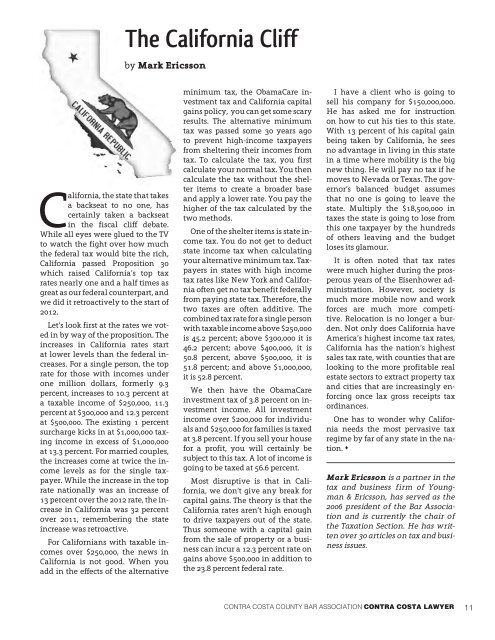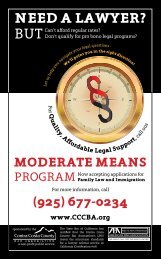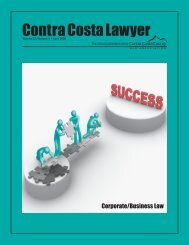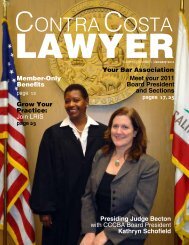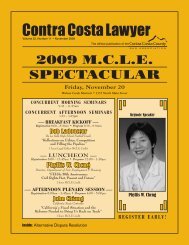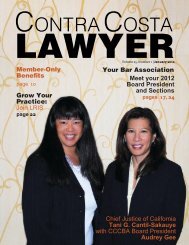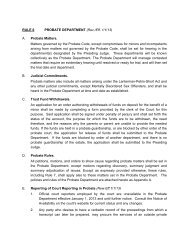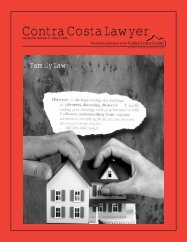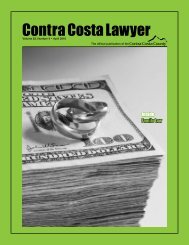download - Contra Costa County Bar Association
download - Contra Costa County Bar Association
download - Contra Costa County Bar Association
You also want an ePaper? Increase the reach of your titles
YUMPU automatically turns print PDFs into web optimized ePapers that Google loves.
The California Cliff<br />
by Mark Ericsson<br />
California, the state that takes<br />
a backseat to no one, has<br />
certainly taken a backseat<br />
in the fiscal cliff debate.<br />
While all eyes were glued to the TV<br />
to watch the fight over how much<br />
the federal tax would bite the rich,<br />
California passed Proposition 30<br />
which raised California’s top tax<br />
rates nearly one and a half times as<br />
great as our federal counterpart, and<br />
we did it retroactively to the start of<br />
2012.<br />
Let’s look first at the rates we voted<br />
in by way of the proposition. The<br />
increases in California rates start<br />
at lower levels than the federal increases.<br />
For a single person, the top<br />
rate for those with incomes under<br />
one million dollars, formerly 9.3<br />
percent, increases to 10.3 percent at<br />
a taxable income of $250,000, 11.3<br />
percent at $300,000 and 12.3 percent<br />
at $500,000. The existing 1 percent<br />
surcharge kicks in at $1,000,000 taxing<br />
income in excess of $1,000,000<br />
at 13.3 percent. For married couples,<br />
the increases come at twice the income<br />
levels as for the single taxpayer.<br />
While the increase in the top<br />
rate nationally was an increase of<br />
13 percent over the 2012 rate, the increase<br />
in California was 32 percent<br />
over 2011, remembering the state<br />
increase was retroactive.<br />
For Californians with taxable incomes<br />
over $250,000, the news in<br />
California is not good. When you<br />
add in the effects of the alternative<br />
minimum tax, the ObamaCare investment<br />
tax and California capital<br />
gains policy, you can get some scary<br />
results. The alternative minimum<br />
tax was passed some 30 years ago<br />
to prevent high-income taxpayers<br />
from sheltering their incomes from<br />
tax. To calculate the tax, you first<br />
calculate your normal tax. You then<br />
calculate the tax without the shelter<br />
items to create a broader base<br />
and apply a lower rate. You pay the<br />
higher of the tax calculated by the<br />
two methods.<br />
One of the shelter items is state income<br />
tax. You do not get to deduct<br />
state income tax when calculating<br />
your alternative minimum tax. Taxpayers<br />
in states with high income<br />
tax rates like New York and California<br />
often get no tax benefit federally<br />
from paying state tax. Therefore, the<br />
two taxes are often additive. The<br />
combined tax rate for a single person<br />
with taxable income above $250,000<br />
is 45.2 percent; above $300,000 it is<br />
46.2 percent; above $400,000, it is<br />
50.8 percent, above $500,000, it is<br />
51.8 percent; and above $1,000,000,<br />
it is 52.8 percent.<br />
We then have the ObamaCare<br />
investment tax of 3.8 percent on investment<br />
income. All investment<br />
income over $200,000 for individuals<br />
and $250,000 for families is taxed<br />
at 3.8 percent. If you sell your house<br />
for a profit, you will certainly be<br />
subject to this tax. A lot of income is<br />
going to be taxed at 56.6 percent.<br />
Most disruptive is that in California,<br />
we don’t give any break for<br />
capital gains. The theory is that the<br />
California rates aren’t high enough<br />
to drive taxpayers out of the state.<br />
Thus someone with a capital gain<br />
from the sale of property or a business<br />
can incur a 12.3 percent rate on<br />
gains above $500,000 in addition to<br />
the 23.8 percent federal rate.<br />
I have a client who is going to<br />
sell his company for $150,000,000.<br />
He has asked me for instruction<br />
on how to cut his ties to this state.<br />
With 13 percent of his capital gain<br />
being taken by California, he sees<br />
no advantage in living in this state<br />
in a time where mobility is the big<br />
new thing. He will pay no tax if he<br />
moves to Nevada or Texas. The governor’s<br />
balanced budget assumes<br />
that no one is going to leave the<br />
state. Multiply the $18,500,000 in<br />
taxes the state is going to lose from<br />
this one taxpayer by the hundreds<br />
of others leaving and the budget<br />
loses its glamour.<br />
It is often noted that tax rates<br />
were much higher during the prosperous<br />
years of the Eisenhower administration.<br />
However, society is<br />
much more mobile now and work<br />
forces are much more competitive.<br />
Relocation is no longer a burden.<br />
Not only does California have<br />
America’s highest income tax rates,<br />
California has the nation’s highest<br />
sales tax rate, with counties that are<br />
looking to the more profitable real<br />
estate sectors to extract property tax<br />
and cities that are increasingly enforcing<br />
once lax gross receipts tax<br />
ordinances.<br />
One has to wonder why California<br />
needs the most pervasive tax<br />
regime by far of any state in the nation.<br />
s<br />
Mark Ericsson is a partner in the<br />
tax and business firm of Youngman<br />
& Ericsson, has served as the<br />
2006 president of the <strong>Bar</strong> <strong>Association</strong><br />
and is currently the chair of<br />
the Taxation Section. He has written<br />
over 30 articles on tax and business<br />
issues.<br />
CONTRA COSTA COUNTY BAR ASSOCIATION CONTRA COSTA LAWYER 11


